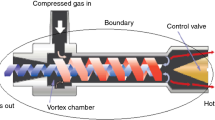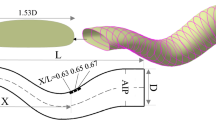Abstract
The working tube is a main part of vortex tube which the compressed fluid is injected into this part tangentially. An appropriate design of working tube geometry leads to better efficiency and performance of vortex tube. In the experimental investigation, the parameters are focused on the working tube angle, inlet pressure and number of nozzles. The effect of the working tube angle is investigated in the range of θ = 0–120°. The experimental tests show that we have an optimum model between θ = 0 and θ = 20°. The most objective of this investigation is the demonstration of the successful use of CFD in order to develop a design tool that can be utilized with confidence over a range of operating conditions and geometries, thereby providing a powerful tool that can be used to optimize vortex tube design as well as assess its utility in the field of new applications and industries. A computational fluid dynamics model was employed to predict the performances of the air flow inside the vortex tube. The numerical investigation was done by full 3D steady state CFD-simulation using FLUENT6.3.26. This model utilizes the Reynolds stress model to solve the flow equations. Experiments were also conducted to validate results obtained for the numerical simulation. First purpose of numerical study in this case was validation with experimental data to confirm these results and the second was the optimization of experimental model to achieve the highest efficiency.














Similar content being viewed by others
Abbreviations
- D :
-
Diameter of vortex tube (mm)
- k :
-
Turbulence kinetic energy (m2 s−2)
- L :
-
Length of vortex tube (mm)
- r :
-
Radial distance from the centerline (mm)
- T :
-
Temperature (K)
- Ti :
-
Inlet gas temperature (K)
- Z :
-
Axial length from nozzle cross section (mm)
- L:
-
Length (m)
- dc:
-
Diameter of cold orifice (m)
- \(\dot{m}\) :
-
Mass flow rate (kg s−1)
- R*:
-
The radius of vortex-chamber
- S:
-
The width of a nozzle
- r*:
-
Truncated cone radius (m)
- G:
-
Truncated ratio
- ΔΤ :
-
Temperature difference (K)
- α :
-
Cold mass fraction
- Ɵ :
-
Cone angle
- ε :
-
Turbulence dissipation rate (m2 s−3)
- ρ :
-
Density (kg m–3)
- σ :
-
Stress (N m–2)
- μ :
-
Dynamic viscosity (kg m−1 s−1)
- μ t :
-
Turbulent viscosity (kg m−1 s−1)
- τ :
-
Shear stress (N m−2)
- τ ij :
-
Stress tensor components
- RWT :
-
The radius of working tube
- RC :
-
The radius of cold orifice
- V:
-
Velocity of flow
- in:
-
Inlet
- c:
-
Cold
- h:
-
Hot
- t:
-
Total
References
Ranque GJ (1933) Experiments on expansion in a vortex with simultaneous exhaust of hot air and cold air. Le J. de Physique et le Radium 4:112–114
Ranque GJ (1934) Method and apparatus for obtaining from a fluid under pressure two outputs of fluid at different temperatures. US Pat 1(952):281
Hilsch R (1947) The use of expansion of gases in a centrifugal field as a cooling process. Rev Sci Instrum 18:108–113
Valipour MS, Niazi N (2011) Experimental modeling of a curved Ranque–Hilsch vortex tube refrigerator. Int J Refrig 34:1109–1116
Dincer K (2011) Experimental investigation of the effects of threefold type Ranque–Hilsch vortex tube and six cascade type Ranque–Hilsch vortex tube on the performance of counter flow Ranque–Hilsch vortex tubes. Int J Refrig 34(6):1366–1371
Xue Y, Arjomandi M, Kelso R (2012) Experimental study of the flow structure in a counter flow Ranque–Hilsch vortex tube. Int J Heat Mass Transf 55(21–22):5853–5860
Im SY, Yu SS (2012) Effects of geometric parameters on the separated air flow temperature of a vortex tube for design optimization. Energy 37(1):154–160
Mohammadi S, Farhadi F (2013) Experimental analysis of a Ranque–Hilsch vortex tube for optimizing nozzle numbers and diameter. Appl Therm Eng 61(2):500–506
Rafiee SE, Rahimi M (2013) Experimental study and three-dimensional (3D) computational fluid dynamics (CFD) analysis on the effect of the convergence ratio, pressure inlet and number of nozzle intake on vortex tube performance-Validation and CFD optimization. Energy. doi:10.1016/j.energy.2013.09.060
Saidi MH, Yazdi MRA (1999) Exergy model of a vortex tube system with experimental results. Energy 24:625–632
Secchiaroli A, Ricci R, Montelpare S, D’Alessandro V (2009) Numerical simulation of turbulent flow in a Ranque–Hilsch vortex tube. Int J Heat Mass Transf 52:5496–5511
Shamsoddini R, Nezhad AH (2010) Numerical analysis of the effects of nozzles number on the flow and power of cooling of a vortex tube. Int J Refrig 33:774–782
Pinar AM, Uluer O, Kırmaci V (2009) Optimization of counter flow Ranque–Hilsch vortex tube performance using Taguchi method. Int J Refrig 32:1487–1494
Chang K, Li Q, Zhou G, Li Q (2011) Experimental investigation of vortex tube refrigerator with a divergent hot tube. Int J Refrig 34:322–327
Stephan K, Lin S, Durst M, Seher F, Huang D (1983) An investigation of energy separation in a vortex tube.Int. J Heat Mass Transf 26(3):341–348
Dincer K, Baskaya S, Uysal BZ (2008) Experimental investigation of the effects of length to diameter ratio and nozzle number on the performance of counter flow Ranque–Hilsch vortex tubes. Heat Mass Transf 44:367–373
Akhesmeh S, Pourmahmoud N, Sedgi H (2008) Numerical study of the temperature separation in the Ranque–Hilsch vortex tube. Am J Eng Appl Sci 3:181–187
Gibson MM, Launder BE (1978) Ground effects on pressure fluctuations in the atmospheric boundary layer. J Fluid Mech 86:491–511
Launder BE (1989) Second-moment closure: present… and Future? Int J Heat Fluid Flow 10(4):282–300
Launder BE, Reece GJ, Rodi W (1975) Progress in the development of a Reynolds-stress turbulence closure. J Fluid Mech 68(3):537–566
Yilmaz M, Kaya M, Karagoz S, Erdogan S (2009) A review on design criteria for vortex tubes. Heat Mass Transf 45:613–632
Gutsol AF (1997) The Ranque effect. Phys Uspekhi 40:639–658
Author information
Authors and Affiliations
Corresponding author
Rights and permissions
About this article
Cite this article
Rafiee, S.E., Ayenehpour, S. & Sadeghiazad, M.M. A study on the optimization of the angle of curvature for a Ranque–Hilsch vortex tube, using both experimental and full Reynolds stress turbulence numerical modelling. Heat Mass Transfer 52, 337–350 (2016). https://doi.org/10.1007/s00231-015-1562-y
Received:
Accepted:
Published:
Issue Date:
DOI: https://doi.org/10.1007/s00231-015-1562-y




